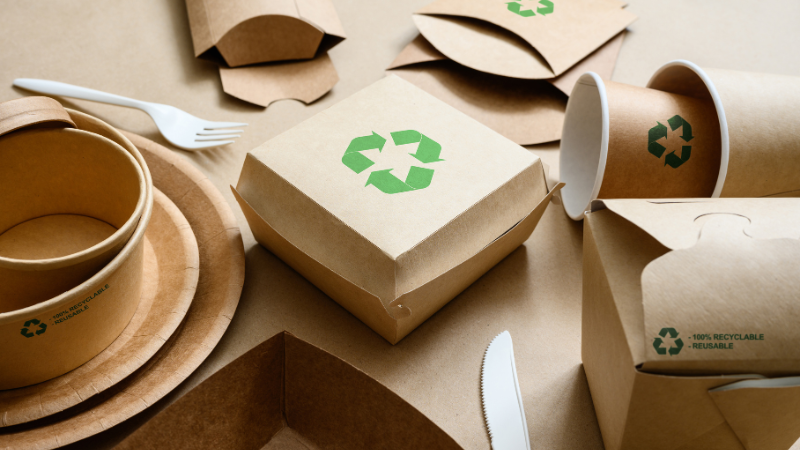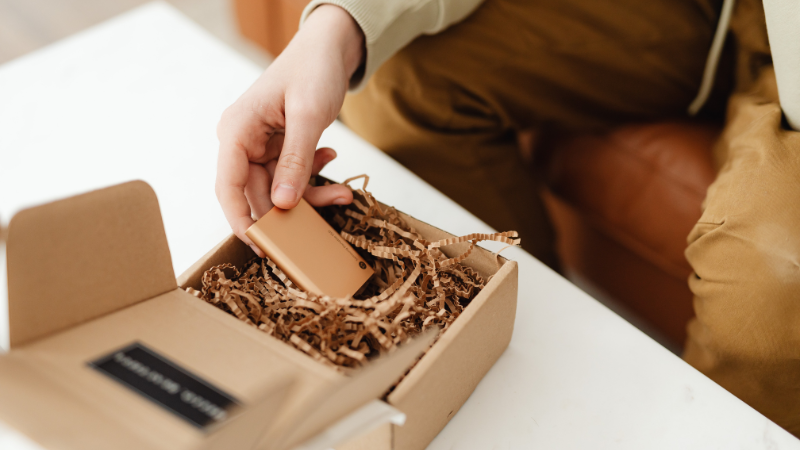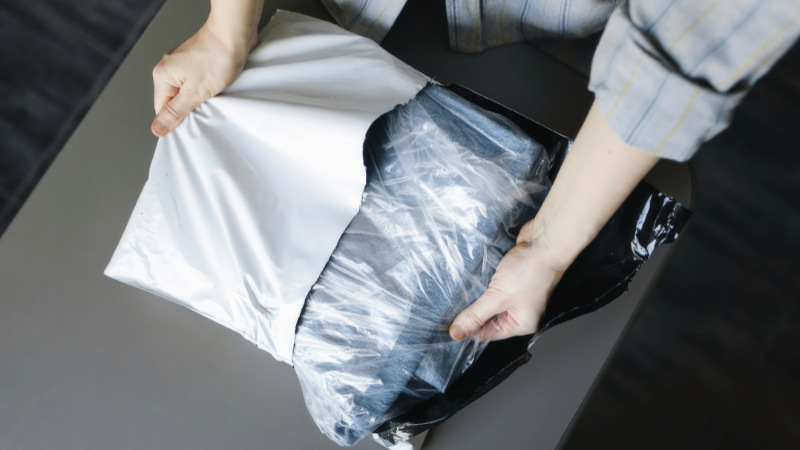
The average American tosses out about 4.9 pounds of trash daily, with packaging making up roughly a third of that waste. That’s nearly 82 pounds of packaging per person each year—and online shopping is pushing those numbers even higher.
Remember when we used to buy most things in stores? Those days seem distant now. The pandemic accelerated our shift to online shopping, and even as life has returned to normal, our digital shopping habits have stuck around. But there’s a cost we don’t often think about: all those boxes, mailers, bubble wrap, and plastic air pillows that protect our purchases.
As a company that works with brands to create recyclable, compostable, and right-sized packaging, Plus Packaging sees this challenge up close. The problem isn’t just the amount of packaging—it’s how much of it is unnecessary, non-recyclable, or designed without the end of its life in mind.
So just how much packaging waste does the average household create through online shopping? And what can we do about it? Let’s look at the numbers behind those piles of cardboard in your recycling bin and explore some practical solutions for both shoppers and sellers.
The Online Shopping Boom and Its Packaging Problem
Online retail sales in the U.S. hit $1.09 trillion in 2022, up 38% from pre-pandemic levels. That’s a lot of packages being delivered to doorsteps across the country.
The math is simple: more online orders mean more shipping boxes, more protective materials, and more waste. A report from Oceana found that Amazon alone generated about 599 million pounds of plastic packaging waste in 2020. And that’s just one company.
Plus Packaging works with retailers to right-size shipments and replace excess plastic with recyclable paper mailers, compostable mailers, and paper-based void fill—solutions that protect products while keeping waste to a minimum. This is especially important given how common it is for shoppers to receive small items in oversized boxes stuffed with unnecessary filler.
What’s in Your Trash? Breaking Down Household Packaging Waste
The average American household receives about 21 packages per year from online shopping. Here’s what that typically adds up to:
| Material Type | Avg. Weight/Household/Year | Environmental Impact |
| Cardboard | 30-40 lbs | Recyclable but energy-intensive to produce |
| Plastic Wrap | 5-8 lbs | Rarely recycled, often landfilled |
| Air Pillows | 3-5 lbs | Low weight but high volume in landfills |
| Foam Inserts | 2-4 lbs | Non-biodegradable, difficult to recycle |
| Tape & Labels | 1-2 lbs | Mixed materials, rarely recycled |
These numbers vary based on shopping habits. Households that order groceries, meal kits, or subscription boxes can generate two to three times this amount. That’s why switching to single-material solutions—like recyclable kraft paper mailers with paper-based tape—makes recycling easier for consumers and reduces landfill waste.
Returns: The Hidden Waste Multiplier
Here’s something most of us don’t think about: returns create double the packaging waste. And Americans return a lot of stuff.
In clothing and fashion, return rates hover between 30-40%. For electronics, it’s around 20%. That “bracketing” habit—buying multiple sizes or colors with the intention of returning what doesn’t work—has become standard practice for many shoppers.
The National Retail Federation estimated that more than $816 billion worth of merchandise was returned in 2022. Of those returns, roughly 9.5 billion pounds of returned goods ended up in landfills.
One way retailers can reduce this waste is by designing packaging that’s reusable for returns. Plus Packaging offers resealable mailers and returnable shipping bags, which help reduce the need for entirely new packaging when items are sent back.
Why Most Packaging Doesn’t Get Recycled

You might dutifully break down your Amazon boxes for recycling, but the reality is that much packaging never gets a second life:
- Only about 66% of paper and cardboard actually gets recycled in the U.S.
- Plastic recycling rates are much worse; just 5-6% of all plastic waste gets recycled.
- Mixed materials (like padded mailers with paper outside and bubble wrap inside) are especially problematic because they need to be separated.
Consumer confusion plays a big role too. Those plastic air pillows? They’re technically recyclable, but only at special drop-off locations, not in your curbside bin. And that plastic wrap around your new shirt? It’s usually too flimsy for recycling facilities to handle.
Food delivery adds another layer of complexity. Those takeout containers, even the ones labeled compostable, often end up in landfills because most municipal composting facilities can’t process them properly.
Beyond the Trash: Carbon Footprint and Resource Depletion
The environmental impact of packaging goes far beyond what ends up in your trash can. There’s also:
- Carbon emissions from manufacturing new packaging materials
- Fuel used in shipping (especially for inefficiently packed items)
- Water used in paper production (it takes about 10 gallons of water to make a single paper bag)
- Trees harvested for cardboard (about 3 billion trees are cut down each year for paper packaging)
Returns make this even worse. Optoro estimates that U.S. returns create about 24 million metric tons of carbon dioxide emissions annually—equivalent to what 5 million cars would produce in a year.
By using lighter, right-sized packaging—like Plus Packaging’s compostable mailers—brands can cut shipping weight, reduce carbon emissions, and still ensure products arrive safely.
How Does the U.S. Compare Globally?
Americans generate more packaging waste per person than almost any other country. Here’s how we stack up:
| Country | Annual Packaging Waste (lbs/person) | Recycling Rate |
| United States | 82 | 32% |
| Germany | 53 | 67.7% |
| Japan | 41 | 87% |
| France | 48 | 42.7% |
| UK | 51 | 44% |
The difference isn’t just in how much waste we create, but in how we handle it. Many European countries have implemented extended producer responsibility (EPR) laws that make manufacturers responsible for the entire lifecycle of their packaging.
Part of the solution is policy, but another part is access to readily recyclable and compostable packaging options—the kind Plus Packaging supplies to brands looking to match European-level recycling performance.
Practical Solutions: What Can We Do?
For Shoppers:
- Consolidate orders whenever possible. That “add to cart” button is tempting, but waiting to place one larger order instead of several small ones reduces packaging waste.
- Choose the “ship in fewest packages” option when available. Amazon and some other retailers offer this.
- Reuse before recycling. Those boxes and mailers can have second lives for storage, shipping gifts, or even craft projects.
- Support brands that use minimal or sustainable packaging. Your purchasing decisions send a message.
- Consider local pickup options when available. Many retailers now offer curbside pickup, eliminating shipping materials entirely.
For Retailers and Brands:
- Right-size your packaging. Using boxes that match product dimensions can reduce material use by up to 40%.
- Switch to sustainable materials. Options like kraft paper mailers, compostable poly bags, and paper-based void fill are increasingly affordable and effective.
- Rethink returns. Offering better sizing guides, virtual try-ons, and clearer product descriptions can reduce return rates.
- Make recycling easy. Clear instructions on packaging about how to recycle each component helps customers dispose of materials properly.
- Consider reusable packaging systems. Companies like Returnity and RePack offer durable shipping containers that can be returned and reused dozens of times.
Packaging Innovation: What’s Coming Next

The future of packaging looks promising, with new materials and systems emerging:
- Compostable mailers: These plant-based alternatives to poly mailers break down completely in industrial composting facilities.
- Smart packaging: QR codes that provide recycling instructions specific to the customer’s location are making proper disposal easier.
- Reusable shipping systems: Some companies are testing deposit systems where customers return shipping containers for reuse, similar to bottle deposits.
At Plus Packaging, we’re helping brands make the switch to more sustainable options with our compostable mailers, recyclable kraft paper tape, and right-sized packaging solutions that reduce waste while still protecting products.
Small Changes, Big Impact
The packaging waste problem can seem overwhelming, but remember that small changes add up quickly. If every online shopper consolidated just one order per month, we’d eliminate millions of boxes from the waste stream annually.
For brands, smarter packaging isn’t just good for the planet—it’s good for business. Customers notice and appreciate sustainable packaging, and right-sizing can significantly reduce shipping costs.
Whether you’re a shopper trying to reduce your environmental footprint or a brand looking to improve your packaging strategy, the first step is awareness. Take a look at your own packaging habits and consider where you might make changes.
The convenience of online shopping isn’t going away, but its environmental impact doesn’t have to be so heavy. With better choices and innovative solutions, we can enjoy the benefits of e-commerce without drowning in packaging waste.
The Real Cost of “Free” Shipping
When we click “free shipping” at checkout, we’re not seeing the full environmental price tag. Free shipping often encourages smaller, more frequent orders—each with its own packaging—rather than bundling items together.
Many retailers also use standardized box sizes for operational efficiency, which means small items often ship in oversized boxes. A study by Forbes found that the average e-commerce package contains about 40% empty space.
This inefficiency creates a cascade of environmental costs:
- More packaging material used than necessary
- Fewer items fitting on delivery trucks (increasing carbon emissions per item)
- More trips required to deliver the same amount of merchandise
- Higher fuel consumption and traffic congestion in residential areas
Some retailers are addressing this by implementing “ship complete” policies that hold orders until all items are available, reducing multiple shipments for a single order. Others use algorithms to determine the optimal box size for each order, reducing waste and shipping costs simultaneously.
The Psychology of Unboxing: Why Packaging Matters

There’s a reason “unboxing videos” have millions of views on YouTube—opening a package is an experience, and brands know it. This has led to the rise of “premium packaging” with multiple layers, special finishes, and elaborate designs.
While beautiful packaging can strengthen brand loyalty, it often comes at an environmental cost. The good news? Sustainable packaging and great unboxing experiences aren’t mutually exclusive.
Brands like Allbirds, Patagonia, and Who Gives A Crap have proven that simple, recyclable packaging can still create memorable customer experiences. Their approach focuses on:
- Minimalist design with high-impact printing
- Single-material packaging that’s easy to recycle
- Clever construction that eliminates the need for tape or adhesives
- Packaging that tells a sustainability story
The key is finding the balance between brand experience and environmental responsibility. A beautifully designed kraft mailer with custom printing can make just as strong an impression as a glossy box with plastic windows—while being much easier to recycle.
Plus Packaging takes a similar approach—helping brands design custom-printed kraft mailers, recyclable paper retail bags, and tissue paper that delight customers while being easy to recycle or compost. This balance keeps the brand experience strong while avoiding unnecessary materials.
The Business Case for Better Packaging
For brands concerned about costs, here’s the good news: sustainable packaging isn’t just better for the planet—it can be better for your bottom line too.
Consider these benefits:
- Reduced shipping costs: Right-sized packaging means lower dimensional weight charges from carriers like UPS and FedEx.
- Lower material costs: Using less material or switching to simpler packaging often reduces per-unit costs.
- Improved customer perception: 67% of consumers consider environmentally friendly packaging important, according to a McKinsey survey.
- Regulatory compliance: As packaging regulations tighten globally, sustainable options future-proof your business.
- Supply chain resilience: Paper-based materials often have more stable supply chains than petroleum-based plastics.
Take the example of Thread, an apparel company that switched from poly mailers to paper-based packaging. They not only reduced their plastic use by 90% but also saved on shipping costs because the paper mailers were lighter and took up less space in transit.
Taking Action: A Packaging Audit for Your Business
If you’re a business owner looking to reduce packaging waste, start with a simple audit:
- Gather samples of all packaging you currently use (primary packaging, shipping materials, void fill, etc.)
- Weigh and measure each component to establish your baseline
- Identify problem areas like oversized boxes, mixed materials, or non-recyclable components
- Replace high-impact items with recyclable, compostable, or reusable alternatives from Plus Packaging.
- Test new solutions with a small batch before scaling up
- Track results in terms of customer feedback, shipping costs, and total material used
This process often reveals quick wins—like switching from plastic air pillows to paper void fill, or using right-sized mailers instead of boxes for soft goods.
The Role of Policy and Industry Standards
While individual action matters, systemic change happens faster when brands and suppliers work together. Plus Packaging helps businesses stay ahead of changes in packaging regulations—ensuring your materials meet evolving environmental standards without disrupting your supply chain.
- Extended Producer Responsibility (EPR) laws are gaining traction in the U.S., following Europe’s lead. These laws make manufacturers responsible for the end-of-life management of their packaging.
- Plastic packaging taxes in countries like the UK are creating financial incentives to reduce plastic use.
- Standardized labeling initiatives like How2Recycle are making it easier for consumers to understand how to properly dispose of packaging.
- Industry commitments like the Ellen MacArthur Foundation’s New Plastics Economy Global Commitment are pushing major brands to set concrete targets for reducing packaging waste.
These policy tools are creating market conditions where sustainable packaging isn’t just an ethical choice—it’s becoming the economically sensible option too.
Looking Forward: The Circular Economy Vision
The ultimate goal isn’t just better disposable packaging—it’s moving toward a circular economy where packaging materials are continuously reused or recycled.
This vision includes:
- Reusable shipping containers that travel back and forth between warehouses and customers
- Deposit systems that incentivize returns of packaging materials
- Closed-loop recycling where materials maintain their quality through multiple lifecycles
- Compostable materials that return nutrients to soil at end of life
- Packaging-as-a-service models where brands maintain ownership of their packaging
Some of these solutions are already working at scale. Loop, a partnership between TerraCycle and major consumer brands, uses durable, reusable packaging for everything from ice cream to shampoo. Customers pay a deposit, and when they’re done with the product, they return the packaging for cleaning and refilling.
Conclusion: Small Steps Toward Big Change
Packaging waste from online shopping isn’t going to disappear overnight, but the situation isn’t hopeless. Every stakeholder in the e-commerce ecosystem has a role to play:
- Shoppers can make more conscious choices about how and where they shop
- Brands can invest in sustainable packaging design and materials
- Retailers can optimize fulfillment processes to reduce waste
- Delivery companies can develop more efficient routes and reusable systems
- Policymakers can create incentives for sustainable packaging and improved recycling infrastructure
The next time you open a package, take a moment to consider its journey and its future. Could it have been designed better? Could you reuse it instead of recycling? These small moments of awareness, multiplied across millions of households, can drive meaningful change.
At Plus Packaging, we’re committed to helping brands find that sweet spot where protection, presentation, and planet-friendly design meet. From compostable mailers to custom printed tape, we’re making it easier for businesses of all sizes to reduce their packaging footprint without compromising on quality or brand experience.
The future of e-commerce doesn’t have to be buried in packaging waste. With thoughtful design, better materials, and smarter systems, we can enjoy the convenience of online shopping while treading more lightly on the planet.